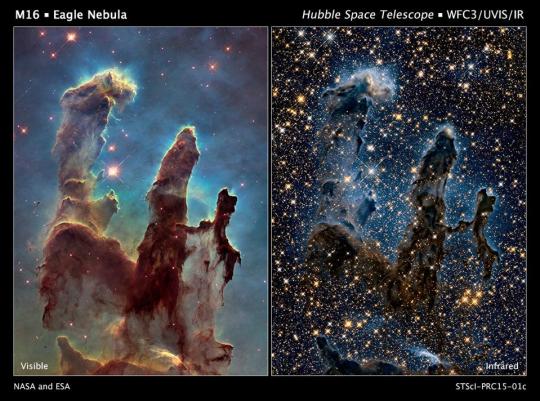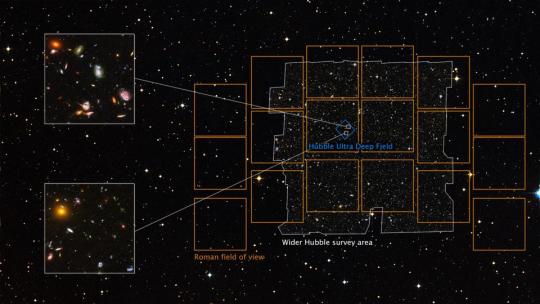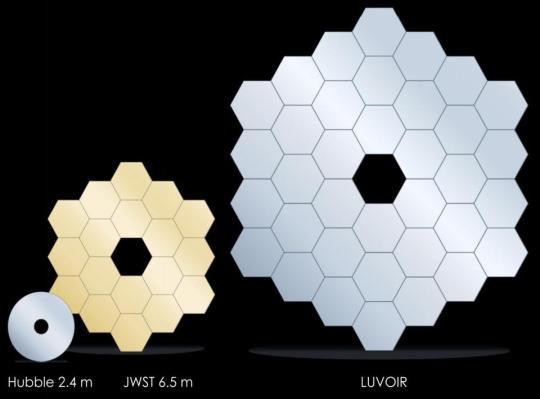#luvoir
Explore tagged Tumblr posts
Text

Space robots stuck on Earth
#oc#original character#character art#character design#luvoir#habex#mega man oc#xenon art#digital art#illustration
71 notes
·
View notes
Note
Starship's user manual (2020) says that they do not need tanker flights to do 21t to Geostationary Transfer Orbit.

LUVOIR-A has a 15m mirror, yes, but it folds to fit in an 8m diameter fairing, as the 2019 LUVOIR report notes. There is a concern that it may not fit in Starship, but that's 2019 numbers and, as you note, Starship is still being iterated on.
You're right that LUVOIR-A would probably require Starship tanking to get to Sun-Earth Lagrange Point 2. LUVOIR-A's maximum expected payload mass is 37,431kg (Table 8-2), or 37.4t for short. The baseline launch vehicle for LUVOIR-A is the SLS Block 2. The SLS Block 2 has a payload of 46t to Trans-Lunar Insertion, and no listed payload to lower orbits. GTO is lower than TLI and so we must conclude that Starship's single-launch payload limit of 21t to GTO means it cannot get 37t to TLI or SEL2 without tanking. I concede that LUVOIR-A would require tanking, and so it's a false example for what I had used it for: large satellite payloads which require Starship even in the absence of tanking.
The need for refueling when using a standard Starship is why some people dream of fully-expendable Starships, but, assuming that refueling works, I think it's better to refuel in LEO, inside the Allen Belts, and then go to your destination from there. If you refuel, you get to take more mass there!
The next question is: Can a Starship be refueled in orbit, and can it store its propellants while in orbit? NASA has been testing this in he abstract with a series of Robotic Refueling Missions. RRM3 successfully demonstrated storage of methane without loss in 2019, and successfully tested connectors for cryogenic propellant transfer. On-orbit transfer of non-cryogenic liquid propellants and oxidizers has been routinely demonstrated since the '70s. I think it's fair to say that in-space refueling is a solved engineering problem, even if there isn't yet an ISO standard for refueling ports. As first mover, Starship will probably set the standard, just as docking ports derived from Apollo-Soyuz hardware are the basis for the current International Docking System Standard.
The real question is: Will SpaceX manage to implement the technology at a larger scale than has previously been demonstrated?
starship doesnt work. the $5 billion spent (not including $2 billion for launches) is not final. additionally $1 billion per launch (for a rocket that doesnt work) compared to $2 billion per launch isnt the difference between $1,000,000 and $100. compared to its competitors starship is not 10,000 times more cost effective it is at best twice as and currently not at all (since it does not work yet)
(this ask received on 2023-12-03)
Anon-kun, I seriously considered saving this ask until after the third Starship launch, currently scheduled for spring 2024. I wonder: did you say these same things about SpaceX's Falcon 9? Back before landing a spacecraft became a routine occurrence, there were many people who complained that SpaceX was wasting money and wasting fuel trying to build a reusable booster. I often wonder what those skeptics say now about the value of reusable rockets.
You say that the Starship does not "work" yet, but I tell you: the SLS does not work at all. The same metrics you use to say that Starship doesn't work apply equally to the SLS, and show that the SLS is financially infeasible.
The traditional space-industrial complex is having trouble building SLS rockets fast enough to meet the Artemis launch cadence: one launch each in 2024, 2025 2026, 2028, 2929. There are concerns that the SLS won't be ready in time to launch astronauts to the Moon, and this, mind you, is for a program which has been running since the 2000s. Artemis 4 has already been delayed to 2026 at the earliest because the required ground support equipment for the SLS Block 1B rocket won't be ready before November 2026.
The next Starship is expected to launch in 3-4 months. SpaceX expects to build an assembly line to build Starships at the rate of one Starship per week. SpaceX plans to sell these launches for $10 million per launch. Even if SpaceX sold launches on the fully-reusable Starship for the same price as the partially-reusable Falcon 9, at about $62 million per launch, that cost is still ... $62m/100t * 95t/$2b = 0.02 ... at Falcon 9 costs, the Starship launches mass to LEO at 2% of the cost of the SLS. The SLS will be priced out of the market, because not even Congress wants to pay $2 billion per launch when you can get the same capability for $62 million per launch. And SpaceX expects the cost to be lower than that.
Sure, there have been many explosions in SpaceX's program. That's because SpaceX is working on a different development model than the space-industrial complex. We saw that with the early Falcon 9 landings: the landing of the rocket was sugar on the cake; the real precious thing was the information received in the attempt, which enables faster iteration. Changing how SLS stages would cost billions of dollars and take 10 years of change orders. SpaceX iterated that in less than a year.
I predict that, by the end of 2024, SpaceX will have successfully orbited a Starship, and will be selling commercial launch slots.
See you next year, nony?
Yes, Musk is an ass, and a fool, and a prating coxcomb. But as long as his ego doesn't cost SpaceX anything, SpaceX is on the path to be selling sub-$100m 100t payloads to Mars by 2030. Is it meet, think you, what we should also, look you, be an ass and a fool and a prating coxcomb? In your own conscience, now?
45 notes
·
View notes
Text

working on this wip still. awfully dysfunctional bunch of dead people
#artists on tumblr#digital art#digital#space probes#from left to right:#perseverance#cassini#giotto#juno#davinci#jimo#and parker#the one way behind them is luvoir#they have too much lore to go into here but trust me when i say that i take the 'space probe' idea very loosely#art wip
5 notes
·
View notes
Text

luvoir/luccia di vincenzo (dream form)
i like to joke that she is like if vasari got put into my very limited understanding of ffxiv dawntrail (the living memory part, mainly)
0 notes
Text
youtube
A Deep Dive Into The Bizarre Future of Telescopes Hoping to see deeper into the universe, scientists and engineers are designing some of the largest and weirdest telescopes ever conceived. Come with our guest host Astro Alexandra on a tour of the telescopes of the future. Hosted by: Astro Alexandra Find Astro Alexandra at https://ift.tt/C2cUMdr ---------- Support SciShow by becoming a patron on Patreon: https://ift.tt/VAxWIPJ ---------- Chapters: 0:00 Intro 1:56 Advantages of utilizing multiple telescopes for comprehensive astronomical research 4:51 The Extremely Large Telescope and the Giant Magellan Telescope 10:36 The Square Kilometer Array Observatory and interferometry 13:58 SPACE TELESCOPES! 14:52 Origins 17:43 LUVOIR 19:47 Habex 21:40 Athena 24:07 SPIDER 25:29 Lunar Crater Radio Telescope 28:57 Sun Based Telescope 30:13 How Telescope technology has changed 31:35 Outro Correction: 26:40 The image here is actually Opportunity, not Perseverance. ---------- Huge thanks go to the following Patreon supporters for helping us keep SciShow free for everyone forever: Adam Brainard, Alex Hackman, Ash, Benjamin Carleski, Bryan Cloer, charles george, Chris Mackey, Chris Peters, Christoph Schwanke, Christopher R Boucher, DrakoEsper, Eric Jensen, Friso, Garrett Galloway, Harrison Mills, J. Copen, Jaap Westera, Jason A Saslow, Jeffrey Mckishen, Jeremy Mattern, Kenny Wilson, Kevin Bealer, Kevin Knupp, Lyndsay Brown, Matt Curls, Michelle Dove, Piya Shedden, Rizwan Kassim, Sam Lutfi ---------- Looking for SciShow elsewhere on the internet? SciShow Tangents Podcast: https://ift.tt/RL7xUBw TikTok: https://ift.tt/RpGYF0d Twitter: http://www.twitter.com/scishow Instagram: https://ift.tt/i0Vwoje Facebook: https://ift.tt/9pJyKfY #SciShow #science #education #learning #complexly ---------- Sources located at this link: https://ift.tt/n3TdZi1 via YouTube https://www.youtube.com/watch?v=3xCRLJjSQAA
0 notes
Link
Planning large astronomical missions is a long process. In some cases, such as the now functional James Webb Space Telescope, it can literally take decades. Part of that learning process is understanding what the mission will be designed to look for. Coming up with a list of what it should look for is a process, and on larger missions, teams of scientists work together to determine what they think will be best for the mission. In that vein, a team of researchers from UC Berkeley and UC Riverside have released a paper describing a database of exoplanets that could be worth the time of NASA’s new planned habitable planet survey, the Habitable Worlds Observatory HWO. Astronomy’s decadal surveys are the starting point for many ambitious projects, and the Astro2020 Decadal Survey didn’t disappoint. It called for NASA to develop a 6-meter space telescope capable of high-contrast observations in optical, infrared, and ultraviolet wavelengths. That project became known as the HWO; its primary mission is to observe 25 different exoplanets in their parent star’s habitable zones and look for biosignatures on them. Essentially, it will be humanity’s best alien finder. While not searching biosignatures, it can also do general astronomy, but knowing what planets to look at is critical to its mission. The first in a series of lectures leading up to the advent of the HWO.Credit – STScI Research YouTube Channel To tackle that part of the project, a NASA project known as the Exoplanet Exploration Program developed a list of 164 candidate exoplanets “whose [hypothetical] exo-Earths would be the most accessible” for the HWO. Mainly, that accessibility had to do with the characteristics of the planet’s parent star, but its separation from that star was also considered. While those are helpful characteristics to consider, there are plenty more factors that we believe go into whether a planet is habitable or not. These include the frequency of flares and the abundance of certain elements in the star itself. That is precisely the kind of information the new catalog contains. Specifically, the measurements the authors collected can be broken down into five categories: stellar element abundance, photometric values, flare rates, variability estimates, and X-ray emissions. However, each of those categories has plenty of nuance in it. For example, the researchers collected 1700 stellar measurements of elemental abundance for 14 different elements. However, they could only find X-ray emission data for 41 of the 168 stars in the catalog. Fraser discusses what exoplanet hunting will look like in the future. The lack of data isn’t surprising, as they were simply collecting data from other publicly available sources. Some of those sources focused on thousands of stars and weren’t paying close attention to the ones needed from this data set. Data came from various places, including the Gaia, TESS, and WISE. Even the database itself was modeled on a similar one, known as ExEP Mission Star List (EMSL), that was originally developed for two other Great Observatories, LUVOIR and HabEx. Each has its own specialization, and while there is some overlap with HWO, the data defining those missions wasn’t complete enough to help define HWO. As such, there is still work to do in drawing up a project definition and finalizing the scientific and technical goals for HWO. The authors pointed out that this paper was only the first of a series of precursor papers that would help flesh out what this new observatory would be able to do. Luckily, the catalog they have created is freely available, so any interested party can explore the data they’ve collected and potentially contribute to some of the future work defined at the end of the paper. There’s always more science to be done. Learn More:Harada et al. – Setting the stage for the search for life with the Habitable Worlds Observatory: Properties of 164 promising planet survey targetsUT – Planning is Underway for NASA’s Next Big Flagship Space TelescopeUT – An Ambitious New Technology Might be Needed to See Other EarthsNASA Science – Habitable Worlds Observatory Lead Image:Artist’s illustration of exoplanets The post Astronomers Identify 164 Promising Targets for the Habitable Worlds Observatory appeared first on Universe Today.
0 notes
Text










Astronomers To NASA: Please, Build This Telescope!
"When the National Academies release their recommendations in just a few weeks, the great hope of astronomers is that at least three of these missions will be chosen to move forward, with LUVOIR, the most powerful and ambitious space-based observatory ever proposed, as the top choice. If we want definitive answers to the biggest questions of all, it takes a big effort and a substantial investment. Considering that the reward is learning that “there’s life on that planet, orbiting another star, right over there,” it’s clear that LUVOIR is the one telescope we must all join together to build."
Seriously, there are dozens, if not hundreds, of potentially habitable Earth-like planets around nearby Sun-like stars. Is there life on them? If we choose to build this next-generation observatory, LUVOIR, we'll know. We won't guess, or speculate, but instead we'll actually know.
NASA, please, build this telescope, and show us whether there's actually life out there on other planets in the nearby Universe!
82 notes
·
View notes
Link
18 notes
·
View notes
Text
Загрязнение воздуха могло бы свидетельствовать о существовании инопланетян
Планируемый космический телескоп LUVOIR (Large UV Optical Infrared Surveyor) сможет искать внезем... Читать дальше »
0 notes
Text




My NASA space telescopes-inspired reploids are all together now! Featuring (left to right): Habex, Luvoir, Lynx and Origins
Habex - The leader. He is the strategist and usually avoids battles but will fight when he has to. Although he looks as though he doesn't take things seriously, he always gets the job done.
Luvoir - The sniper. He was activated before his other siblings due to an error and he left to hunt Mavericks on his own. He eventually became a Maverick himself and reunited with his siblings through battle.
Lynx - The assassin. Unlike Luvoir, she prefers fighting in close hand combat and is stealthy enough to travel around undetected. She was created to work well with Luvoir.
Origins - The navigator. He has very sensitive vision and can detect the slightest movements and changes in the surrounding. Assists his siblings when they battle and will step in to protect them when the battle gets tough.
#oc#original character#character art#character design#xenon art#habex#luvoir#lynx#origins#megaman#rockman#mega man#mega man oc#megaman oc#rockman oc#mega man x#megaman x#rockman x#space#space oc#digital art#reploid#reploid oc
95 notes
·
View notes
Photo

Largest space telescope ever fielded, LUVOIR, could aid in search for alien life via /r/space http://ift.tt/2zZ2cC4
2 notes
·
View notes
Photo






They had a pretty great Christmas! ~
3 notes
·
View notes
Text

luvoir (like the upcoming space probe)
1 note
·
View note
Text
Why smart telescopes are the future of astrophotography
Is it time you got a ‘smart telescope’? Interest in space and astronomy has never been greater, but if you’ve ever bought a telescope, you know that setting them up is a pain and often gives you a poor quality view of the night sky. Credit social media Instead of being an expert in the night sky, you need to be an expert in how to choose, align and maintain telescopes. It’s an easy way to…

View On WordPress
#4 future space telescopes#astrophotography#astrophotography with phone#evscope telescope review#four future space telescopes nasa wants to build#future telescopes in space#habex space telescope#luvoir telescope nasa#lynx space telescope#lynx x-ray telescope#smarphone astronomy#smart astronomy#smart telescope#smartphone telescope#space telescopes#space telescopes of the future#stellina smart telescope#stellina telescope review
0 notes
Photo

thanks for making me into an emoji @luvoir
1 note
·
View note
Photo










One Of These Four Missions Will Be Selected As NASA's Next Flagship For Astrophysics
“Choosing which of these missions to build and fly will, in many ways, inform our plans for the next 30 years (or more) of astronomy. NASA is the pre-eminent space agency in the world. This is where science, research, development, discovery, and innovation all come together. The spinoff technologies alone justify the investment, but that's not why we do it. We are here to discover the Universe. We are here to learn all that we can about the cosmos and our place within it. We are here to find out what the Universe looks like and how it came to be the way it is today.
People will always argue over budgets — the penny-pinchers are always happy to propose something that's faster, cheaper, and worse — but the reality is this: the budget for NASA Astrophysics as a whole is just $1.35 billion per year: less than 0.1% of the federal discretionary budget and less than 0.03% of the total federal budget. And still, for that tiny amount, NASA has steadily built a flagship program that's the envy of the free world.”
Every 10 years, NASA performs a decadal survey, where it outlines its highest mission priorities for the next 10 years. The 2020 decadal is happening imminently, and once the recommendations are submitted to the National Resource Council at the National Academies of Science, the four flagship finalists will be ranked. This will determine NASA astrophysics’ direction for the 2030s.
James Webb is the flagship for the 2010s; WFIRST is it for the 2020s. What will we choose for the 2030s? It will be one of these four finalists! Dream big, everyone.
132 notes
·
View notes